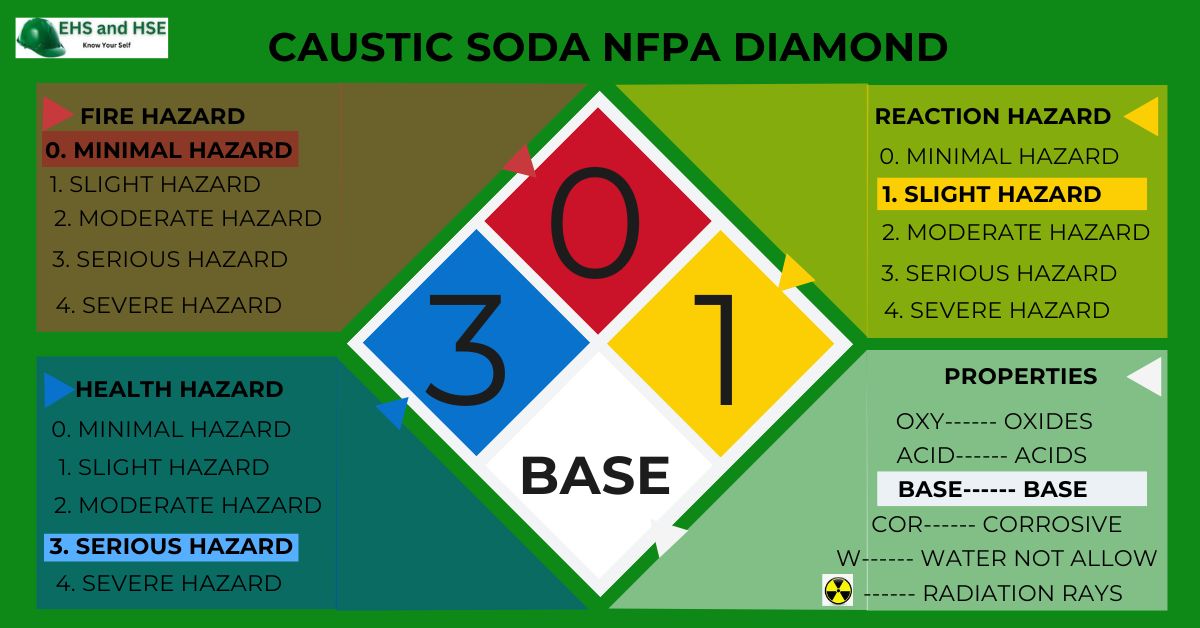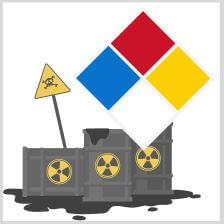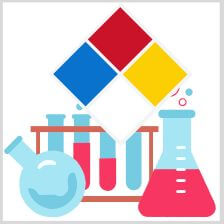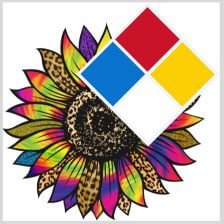What is NFPA Diamond?
(National Fire Protection Association)NFPA diamond
NFPA stands for National Fire Protection Association and the sign shape is like a diamond with four different colors. This standard of NFPA is also called NFPA 704. This is a standard for safety against using different types of liquids like diesel, petrol, and chemicals. This is not only defined as fire risk it also defines human risk, environmental risk, and chemical reaction result risk. In this diamond 4 colors present 4 different risks defined below.
The meaning of NFPA diamond is a big square shape that includes 4 square shapes in it. Each shape has its specific color to identify the specific hazard. Here 4 different types of hazards that directly affect to the human.
- Health Hazard
- Fire Hazard
- Chemical reaction hazard
- Properties/Specific Hazard
NFPA Diamond Guide
The purpose of the NFPA diamond guide is to read and understand the hazards of the chemical. According to fire safety at chemical storage and use. In health safety, how to protect yourself from the hazards of this chemical? Reaction safety defines, how to safely use this chemical.
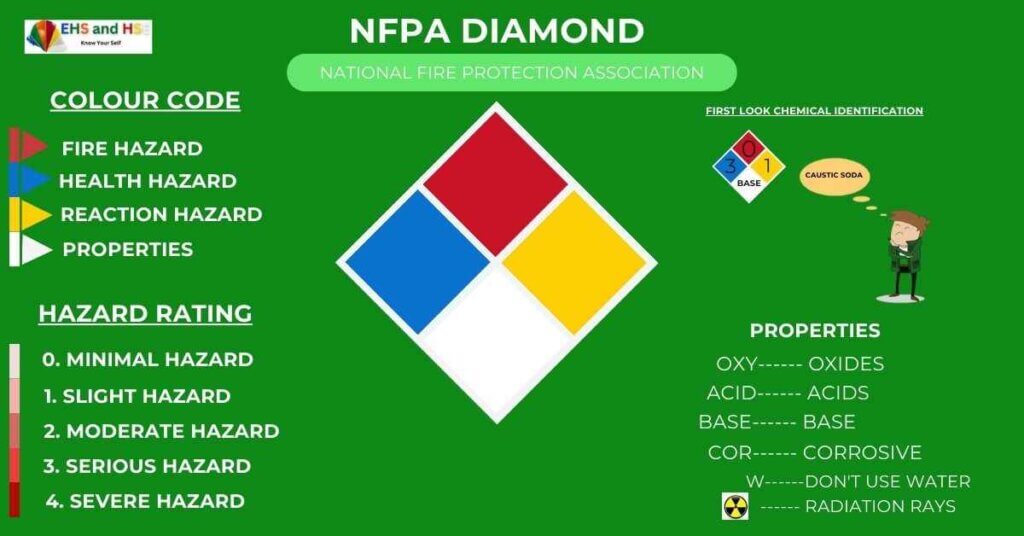
How to read NFPA diamond
NFPA diamond guides us in understanding the hazards of the present elements like gas, liquid, or solid. Using the letters(0 to 4) on the image, we identify the significance of each section on the NFPA diamond. The letter 0 to 4 is called the rating of the hazard of the chemical. The zero “0” hazard rating of the chemical is a minimal hazard rating and the rating “4” is a severe hazard of the chemical. The colors of the sections define the types of hazards.
1. RED (Fire Risk)
Red presents/refers to fire risk with a risk rating. The red color is commonly used for fire risks and hazards of fire.
2. BLUE (Health Hazard)
Blue presents/refers to a risk for the human body with a risk rating. The negative effect on the human body is referred to by the blue color is common.
3. YELLOW (Reaction)
Yellow presents/refers to chemical reaction risk with other chemicals risk with rating. In NFPA diamond colors the Yellow color refers to the Chemical reaction with other chemicals.
4. WHITE (Properties)
White presents and refers to the specific risk of chemicals and their properties.
NFPA diamond ratings.
Red Color Area Rating Hazard
0. Minimal Hazard. Not burnable
1. Slight Hazard. This chemical can burn when accessed temperature from 93C*.
2. Moderate Hazard. This chemical burns below the temperature of 93C*.
3. Serious Hazard. This chemical can burn at a below temperature of 38C*.
4. Severe Hazard. This chemical can burn at a below temperature of 23C*.
Blue Color Area Rating with Hazard
0. Minimal Hazard. This chemical is not harmful to humans.
1. Slight Hazard. This chemical can be temporarily harmful if used without proper safety for a long time.
2. Moderate Hazard. This chemical can be permanently harmful if used without proper safety for a long time.
3. Serious Hazard. This chemical is seriously and permanently harmful if used without proper safety for a short time.
4. Severe Hazard. This chemical can cause death or severe disease if used without proper safety for a short time.
Yellow Color Area Rating with Hazard
0. Minimal Hazard. This chemical can’t react with another chemical at normal temperature.
1. Slight Hazard. This chemical is stable but it can react when increasing temperature and pressure.
2. Moderate Hazard. This chemical burns below the temperature of 93C*. This chemical can be blasted in reaction with water at high pressure and temperature.
3. Serious Hazard. This chemical itself has blast property it blasts when with a water reaction.
4. Severe Hazard. This chemical itself has blast property it can blast at normal temperature and pressure.
White Color Area Chemical Properties
Oxy ← oxides
ACID ← acid
BASE ← base
COR ← corrosive
W ← don,t use water
☢ ← Radiation Rays
Example of NFPA.
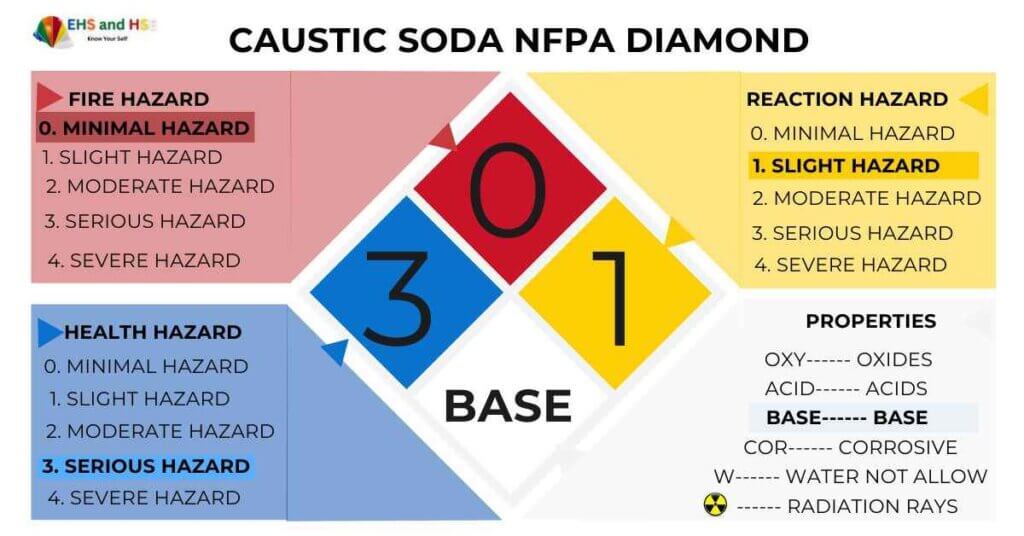
Caustic soda. The NFPA rating of caustic soda is (0,3,1, Base)
0. Not burnable. Minimal Hazard
3. Serious Harmful to humans
1. Can react when pressure and temperature increase. Slight Hazard
Base. The nature of caustic soda is base.
Importance of NFPA diamond.
This NFPA diamond plays an important role in understanding the hazards of chemicals.
- It gives a sign of awareness to us about the hazards of the chemicals before using them.
- It creates confidence about chemical hazards before contact with chemicals.
- For the understanding of chemical properties at First-look.
- It describes the hazards of chemicals and hazard ratings in a single image.
Purposes of NFPA diamond.
NFPA diamond applies only to liquids like chemicals, acids, bases, and petroleum products.
NFPA rating is essential in chemical handling and chemical use. The shortcodes of NFPA diamond show the complete details of chemical properties and their behavior.
According to the chemical, ‘s NFPA rating, we use safety precautions during handling and use it. As well as We also decided on the storage place of chemicals according to their NFPA rating. Like keep away from fire, keep away from eatables, and keep away from other chemicals.
Placement of NFPA.
NFPA (National Fire Protection Association) diamond image should be placed on building entrances, exterior walls, storage areas, chemical tanks, containers, secondary containments, and cans. This diamond with chemical rating should be printed on related chemical MSDS or SDS sheets and also on storage tanks, drums, cans, etc…
NFPA Diamond Signs and Labels1
NFPA signs should be placed at chemical stores, chemicals above storage tanks, Chemical use areas, chemical tankers, and Petrol pumps. Signs of NFPA and some other important information about chemicals should be passed on drums, cans, and bottle bodies in the shape of labels.
Chemicals that need NFPA
- Oils, Fuels, Flammables, and Lubricants.
- Acids and Toxic chemicals
- Chemicals and Descalers
- Dyes, colors, and sprays

